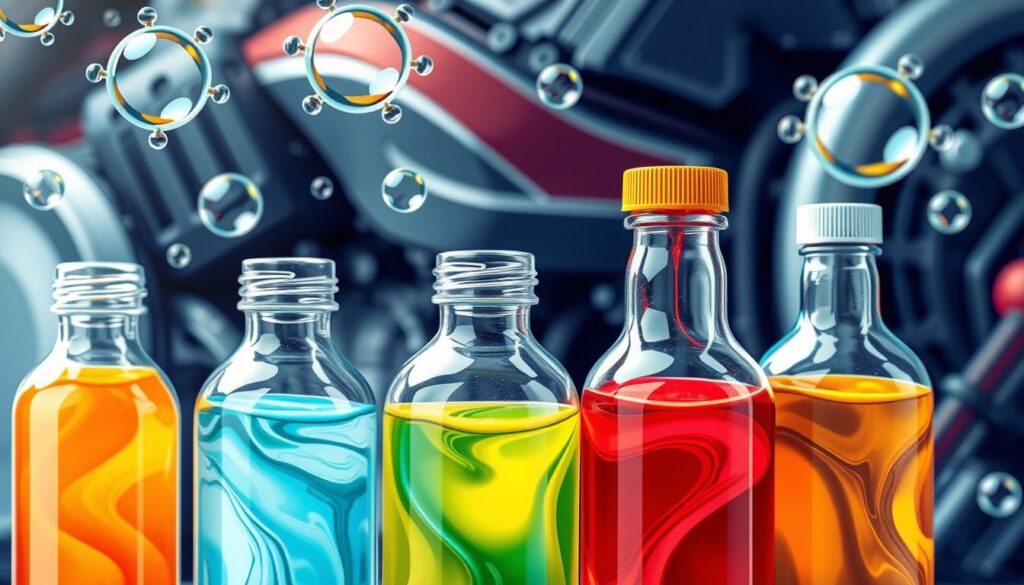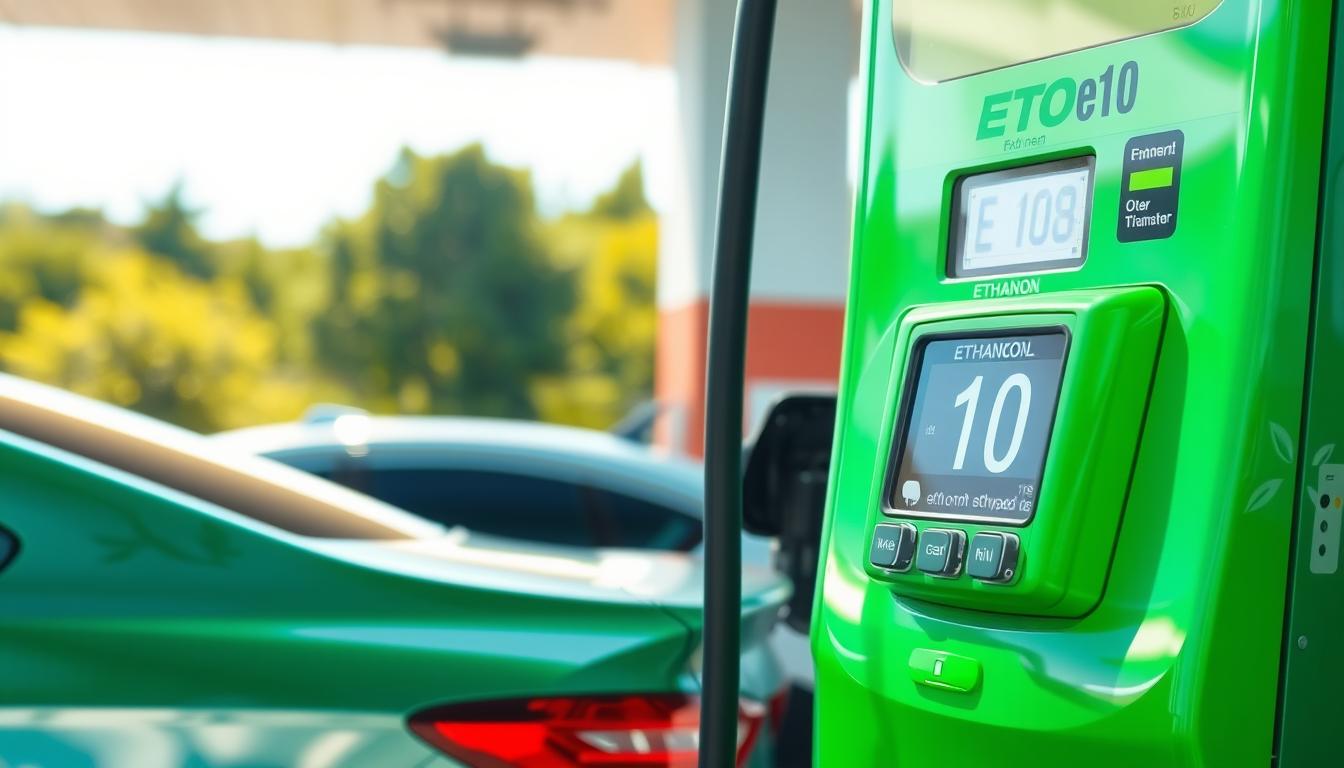E10 fuel, a mix of gasoline with 10 percent ethanol, is becoming more popular in the US. Many worry about its effect on engines. I will look into the truth and myths about E10 fuel and its impact on engines.
Contents
- 1 Introduction to E10 Fuel and Its Impact on Engines
- 2 Does E10 Fuel Damage Engines? Separating Fact from Fiction
- 3 Myth: Ethanol-Enhanced Gasoline (E10) Loses Octane Faster
- 4 Myth: E10 Attracts Water, Necessitating Water Separators
- 5 The Role of Fuel Additives in Preventing Phase Separation
- 6 Best Practices for Storing and Maintaining E10 Fuel
- 7 Transitioning to E10 Fuel: Potential Issues and Solutions
- 8 Expert Insights and Industry Perspectives on E10 Fuel
- 9 Source Links
Key Takeaways
- E10 fuel is safe for all outboard marine engines, say major manufacturers.
- More than 90 percent of gasoline sold in the US for boats, cars, and small engines has up to 10 percent ethanol. No problems have been reported.
- Ethanol is seen as a clean, renewable resource and octane booster. It helps reduce dependence on foreign oil and cuts toxic exhaust emissions.
- Fuel additives can’t fix stale or phase-separated gasoline, experts agree.
- Keeping the fuel tank full to stop condensation is key to avoiding phase separation in E10 fuel.
Introduction to E10 Fuel and Its Impact on Engines
E10 fuel mixes traditional gasoline with 10% ethanol, a renewable alcohol-based fuel. This blend can improve combustion and cut down on emissions. But, it also raises worries about engine corrosion and phase separation.
Understanding the Composition of E10 Fuel
E10 fuel has 10% ethanol, more than the old E5 fuel’s 5%. This higher ethanol level could help the environment by cutting CO2 emissions by up to 750,000 tonnes yearly. That’s like taking 350,000 cars off the road.
Potential Benefits and Drawbacks of Using E10 Fuel
There’s a lot of debate about E10 fuel, especially how it compares to E5 and its effect on fuel economy. In the UK, about 600,000 vehicles in 2021 couldn’t run on E10 fuel, mainly older cars. This has raised concerns about engine compatibility and damage to older or classic vehicles.
But, E10 fuel’s higher ethanol can lead to better combustion and fewer emissions. Yet, the US Energy Information Administration says fuel economy might drop by about 3% with E10 compared to pure unleaded. Classic car owners might also see damage to seals, plastics, and metals from bioethanol’s corrosive nature.
“The introduction of E10 fuel is equivalent to taking 350,000 cars off the road, as stated by the Department for Transport.”
Does E10 Fuel Damage Engines? Separating Fact from Fiction
E10 fuel, with its 10% ethanol, has raised questions about its effect on engines. Some say it can harm engines, but others believe it’s just a myth. Let’s look at what’s true and what’s not.
Experts at Autocar say E10’s higher ethanol can corrode rubber and other materials in older engines. This might cause deposits to block fuel systems. There are also reports of E10 damaging rubber parts in boats, leading to breakdowns.
But, cars made from 2012 on usually don’t have big problems with E10. Some owners prefer fuels like Esso Synergy Supreme or BP Momentum, which have less ethanol. These are better for classic or vintage cars.
- Motorcycle owners often choose ethanol-free fuel because it doesn’t harm rubber and doesn’t absorb water, which can cause problems when not used for a while.
- Some people use E10 for months without issues, showing the key role of proper fueling to avoid damage.
- Concerns about rubber and water issues with E10 have led to suggestions of using E5 fuel or other options like Aspen for older cars.
In summary, E10 might be risky for older engines and some vehicles, but it’s usually okay for newer cars. Using fuel additives and considering other fuel types can help avoid problems with E10.
Myth: Ethanol-Enhanced Gasoline (E10) Loses Octane Faster
Many think E10 fuel loses octane quickly, making engines run poorly over time. But, the truth is different when we look closely at octane loss in E10 fuel.
Exploring the Rate of Octane Loss in E10 Fuel
Studies show E10 fuel doesn’t lose octane faster than regular gasoline. Octane loss depends on storage conditions, temperature, and fuel stabilizers.
In winter, cars sit still longer, making octane loss more likely. Fuel stabilizers are key here. They keep octane levels up, helping both E10 and regular gasoline last longer.
| Fuel Type | Octane Loss Over 6 Months | Octane Loss Over 12 Months |
|---|---|---|
| E10 Fuel | 1-2 octane points | 2-3 octane points |
| Regular Gasoline | 1-2 octane points | 2-3 octane points |
The table shows E10 and regular gasoline lose octane at a similar rate over time. Using fuel stabilizers and proper storage helps reduce this loss. This means E10 and regular gasoline perform similarly over the long haul.

“Proper winterization and the use of fuel stabilizers are key to maintaining octane levels in E10 fuel, just as they are with regular gasoline.”
In conclusion, the idea that E10 loses octane faster than regular gasoline is wrong. With proper storage and fuel stabilizers, E10 keeps its octane levels steady. This ensures engines run well all year.
Myth: E10 Attracts Water, Necessitating Water Separators
Many think E10 fuel pulls in water, needing water separators to avoid engine damage. But, the truth is more detailed. E10 fuel is a bit more likely to draw water than pure gasoline. Yet, the real reasons for water in fuel systems are complex.
Water in fuel systems mainly comes from condensation, not E10 fuel itself. When temperatures change, moisture in the air can turn into water in the fuel tank. This leads to phase separation, where fuel and water parts. This problem isn’t just for E10 fuel; it can happen with any gasoline, with or without ethanol.
| Fuel Property | Pure Gasoline | E10 Fuel |
|---|---|---|
| Water Absorption Tendency | Low | Moderate |
| Susceptibility to Phase Separation | Moderate | Slightly Higher |
| Recommended Use of Water Separators | Generally Not Necessary | Beneficial, but Not Mandatory |
Water separators can help with water in fuel systems, but they’re not always needed for E10 fuel. Using fuel additives and keeping up with maintenance is often more crucial. These steps help prevent and fix water issues in E10 fuel systems.
To sum up, the idea that E10 fuel pulls in water and needs water separators is wrong. Real water problems come from complex causes. They can be managed with proper fuel storage, additives, and regular maintenance, no matter the ethanol level.
The Role of Fuel Additives in Preventing Phase Separation
More gasoline in the U.S. now has ethanol, with more expected soon. This means we must tackle the challenges ethanol-blended fuels bring. One big issue is phase separation, where water and ethanol split from the gasoline. This can harm fuel systems and engines.
Examining the Effectiveness of Fuel Additives for E10 Fuel
Fuel additives are seen as a way to fix E10 fuel problems. They aim to stop water attraction, varnish, and corrosion in ethanol-blended fuels. But do they really keep fuel quality up and engines safe?
Experts say using a non-alcohol fuel stabilizer and treatment, like STA-BIL® Ethanol Treatments, helps. These additives should be added with every fill-up. They protect cars, small engines, and marine engines from ethanol problems.
Tests show that E20 fuels don’t harm current cars or fuel systems. They also showed 20-year resistance to corrosion on 19 metals with E10 and E20 blends. This means fuel additives can lessen the risks of high ethanol in gasoline.
But remember, fuel additives aren’t a full fix. Proper fuel storage and upkeep are also key. Checking old fuel systems, sealing containers, and removing old fuel for storage are important steps. They help keep engines running well on ethanol-blended fuels.
| Fuel Additive | Key Benefits | Limitations |
|---|---|---|
| STA-BIL® Ethanol Treatments |
|
|

“Using a non-alcohol fuel stabilizer and treatment is recommended to prevent phase separation and corrosion in fuel systems.”
Best Practices for Storing and Maintaining E10 Fuel
Storing and maintaining E10 fuel right is key to keeping it stable and avoiding problems like phase separation. Knowing how E10 fuel works helps you use smart strategies. These strategies help reduce condensation, stop phase separation, and keep the fuel quality high for a long time.
Strategies to Prevent Phase Separation and Minimize Condensation
E10 fuel usually lasts about six months, but can last over a year if stored right. Unlike straight gasoline, E10 can hold up to 5000 ppm of water before it separates. But, don’t keep E10 fuel too long as ethanol and gasoline can split apart with a lot of water (more than 0.5% or 5000 ppm).
To stop phase separation and cut down on condensation, follow these tips:
- Keep E10 fuel in a clean, dry, and tightly closed container to reduce moisture.
- Use fuel stabilizers and additives made for E10 fuel to keep it stable and stop phase separation.
- Don’t keep E10 fuel in equipment tanks for more than a few weeks. Make sure to empty the system before storing for the season.
- Think about using non-ethanol fuel with a stabilizer for equipment that will be stored for a long time.
Regularly flushing the fuel system and keeping fuel filters clean also helps keep your E10-powered equipment running well.
By using these best practices, you can make sure your E10 fuel stays stable and free from problems like phase separation and condensation. This keeps your equipment running smoothly.
Transitioning to E10 Fuel: Potential Issues and Solutions
Switching from traditional gasoline (E0) to E10 fuel can be tricky, especially for older engines and fuel systems. As more people use E10 fuel, it’s important to know how to handle the challenges it brings. We’ll look at the issues you might face and how to overcome them.
Engine Compatibility Concerns
One big worry is if your engine will work with E10 fuel. Cars made before 2001 might not like the extra ethanol in E10. This could cause corrosion, swelling of parts, and even make your car run poorly. Always check your car’s manual to see if it’s okay for E10 fuel.
Fuel System Modifications
If your engine can’t handle E10 fuel, you might need to make changes. You might need to replace fuel lines, seals, and gaskets. It’s best to get help from a pro to make sure everything works right with E10 fuel.
Engine Maintenance Considerations
Switching to E10 fuel might mean you need to take better care of your engine. The extra ethanol can wear out parts faster and cause problems. Regular checks, cleanings, and maintenance can help keep your engine running well with E10 fuel.
By tackling these issues and finding solutions, drivers can easily switch to E10 fuel. This way, they can keep their cars running smoothly and reliably.
| Potential Issue | Solution |
|---|---|
| Engine Compatibility Concerns | Consult owner’s manual or manufacturer to determine suitability for E10 fuel |
| Fuel System Modifications | Replace fuel system components like lines, seals, and gaskets to ensure compatibility |
| Engine Maintenance Considerations | Perform regular inspections, cleaning, and preventative maintenance |
“The transition to E10 fuel presents unique challenges, but with the right preparation and maintenance, drivers can ensure their engines continue to perform optimally.”
Expert Insights and Industry Perspectives on E10 Fuel
As E10 fuel becomes more popular, experts and engine makers share their views. Companies like General Motors and Toyota give advice on using E10 fuel. They stress the need to follow the fuel guidelines in the owner’s manual.
Gasoline producers and groups like the Renewable Fuels Association support E10 fuel. They see it as good for the environment and works with most cars. But, AAA has concerns about E15 and its effects on engines, emissions, and fuel use.
Environmental experts talk about the big picture of ethanol-blended fuels. Using E10 can cut down on greenhouse gases from cars. But, making and moving ethanol also affects the environment. As we look at ethanol’s role in our fuel mix, we need to hear from many sides. This includes industry, engine makers, and green groups to make sure we use ethanol right.
Source Links
- https://www.outdoorsfirst.com/article/separating-fact-and-fiction-e10-fuel-and-your-boat-engine/ – Separating fact and fiction: E10 fuel and your boat engine | OutdoorsFIRST
- https://www.boatus.com/expert-advice/expert-advice-archive/2014/january/three-ethanol-myths-clarified – Three Ethanol Myths Clarified
- https://www.cadillacforums.com/threads/e10-in-pre-2000-cars.1073256/ – E10 in pre-2000 cars?
- https://www.rac.co.uk/drive/advice/emissions/what-is-e10-fuel-and-how-could-it-affect-you/ – What is E10 fuel and how will it affect you? | RAC Drive
- https://www.gilbarco.com/eu/blog/everything-you-need-know-about-e10-fuel – Everything you need to know about E10 fuel
- https://www.redexadditives.com/blog/e5-versus-e10-petrol-whats-changing-and-how-will-it-affect-my-car/ – E5 versus E10 Petrol: How Does it Affect My Car? – Redex
- https://forum.tz-uk.com/showthread.php?505340-Is-the-E10-fuel-damaging-our-cars – Is the E10 fuel damaging our cars ?
- https://cars4starters.com.au/the-shocking-truth-about-e10/ – The shocking truth about E10 | cars4starters
- https://www.greencarreports.com/news/1099202_ethanol-free-gasoline-is-more-corrosive-than-e10-research-says – E10 Is Less Corrosive Than Ethanol-Free Gasoline, Research Says
- https://www.flyinggiants.com/forums/showthread.php?t=68624&page=5 – Fuel Choice – Octane vs. Ethanol – Page 5
- https://www.carsguide.com.au/urban/hacks/unleaded-vs-e10-the-comparison-test-66858 – Unleaded vs E10 – the comparison test
- https://www.goldeagle.com/tips-tools/considering-ethanol-free-gas-try-ethanol-treatment-instead/ – Considering Ethanol-Free Gas? Try An Ethanol Treatment Instead
- https://www.bbcboards.net/showthread.php?t=25830 – Mercurys take on Ethanol blended fuel
- https://www.goldeagle.com/tips-tools/what-are-the-effects-of-ethanol-in-gasoline-and-how-to-protect-your-engines-against-it/ – What are the Effects of Ethanol in Gasoline and How to Protect your Engines Against it?
- https://extension.okstate.edu/fact-sheets/ethanol-gasoline-blends-and-small-engines.html – Ethanol Gasoline Blends and Small Engines – Oklahoma State University
- https://www.mncorn.org/2022/03/01/setting-the-record-on-using-ethanol-in-small-engines/ – Ethanol in Small Engines – What You Need to Know | MCGA
- https://www.powerequipmentforum.com/threads/yes-or-no-to-use-e10-fuel-in-generators-with-stabilizer.25349/post-95077 – Yes or no to use E10 fuel in generators with stabilizer
- https://news.engin.umich.edu/2020/05/were-doing-ethanol-wrong/ – We’re doing ethanol wrong
- https://www.hayter.co.uk/blog/revealed:-the-benefits-of-transitioning-from-e5-to-e10-petrol – The Benefits of Transitioning from E5 to E10 Petrol
- https://wvs-cars.co.uk/blog/the-many-pros-and-cons-of-the-great-e10-switch-part-one/ – The Many Pros and Cons of the Great E10 Switch – Part One – WVS – Wales’ independent Volkswagen, Audi, Seat & Skoda Specialists
- https://www.ewg.org/research/higher-ethanol-blends-may-harm-health-and-engines – Higher Ethanol Blends May Harm Health and Engines
- https://www.fenderbender.com/news/article/55044357/aaa-speaks-out-against-raising-ethanol-content-in-gasoline-to-15-percent – AAA speaks out against raising ethanol content in gasoline to 15 percent

Hi, I’m Sufiyan, the developer behind this platform. I created FuelConsumptionCalculator.com to simplify fuel tracking for everyone — because understanding your vehicle shouldn’t require a degree in mechanics. I’m always working on adding more tools and content to make this site even more useful

